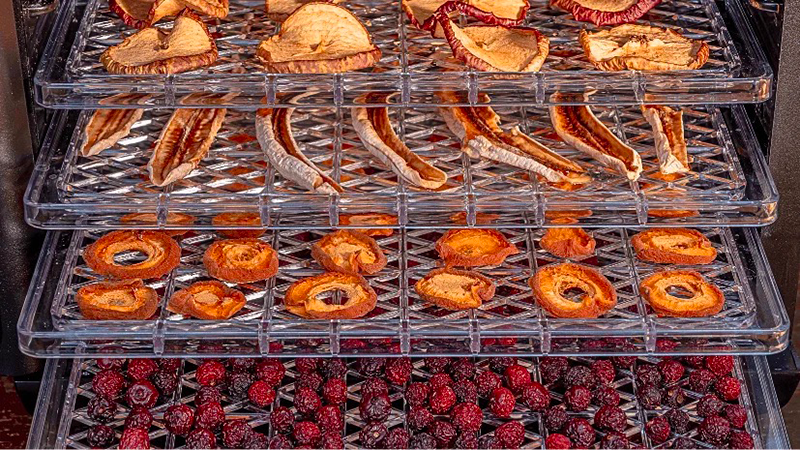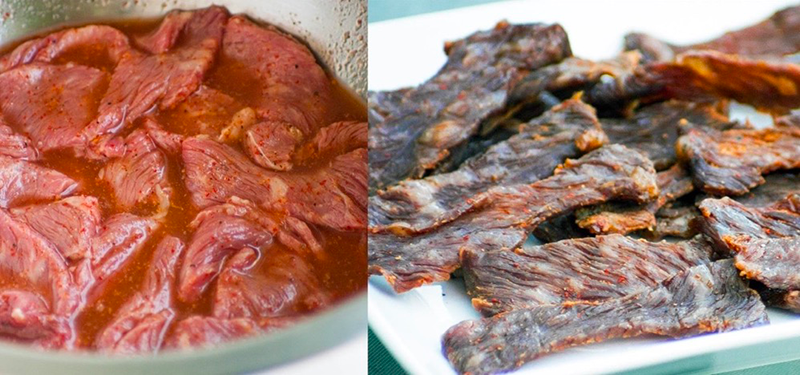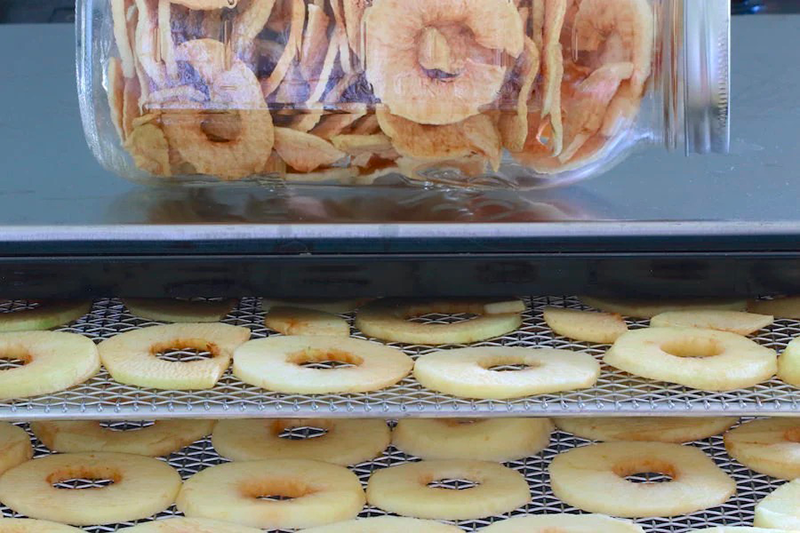
Content Menu
● Understanding Food Dehydrators
● Energy Consumption of Food Dehydrators
● Average Electricity Consumption
● Cost Implications
● Factors Affecting Electricity Consumption
● Tips for Reducing Energy Consumption
● Additional Considerations
>> Choosing the Right Dehydrator
>> Comparing Dehydrators with Other Methods
● Conclusion
● FAQ
>> 1. How much electricity does a typical food dehydrator use?
>> 2. Can I run my food dehydrator overnight?
>> 3. Are there any energy-efficient models available?
>> 4. How does using a food dehydrator compare to using an oven?
>> 5. What are some tips for using a food dehydrator efficiently?
● Citations:
Food dehydrators are becoming increasingly popular among home cooks and health enthusiasts. They offer a practical and efficient way to preserve fruits, vegetables, and meats by removing moisture, which helps inhibit the growth of bacteria and mold. However, many potential users often wonder, does a food dehydrator use a lot of electricity? This article will delve into the energy consumption of food dehydrators, factors affecting their electricity usage, cost implications, and tips for efficient use.

Understanding Food Dehydrators
Food dehydrators operate by circulating warm air around food to evaporate moisture. This process not only preserves food but also concentrates flavors and nutrients. Unlike conventional ovens, which can consume significantly more energy due to their larger size and higher power requirements, food dehydrators are specifically designed for low-temperature operations that efficiently remove moisture.
Energy Consumption of Food Dehydrators
The energy consumption of a food dehydrator can vary based on several factors:
- Wattage: Most food dehydrators range from 300 to 1,500 watts. A typical model may use around 600 to 800 watts per hour. For example, a 600-watt dehydrator running for 8 hours would consume approximately 600watts / 1000 x 8hours = 4.8kWh of electricity.
- Usage Duration: The longer the dehydrator runs, the more electricity it consumes. If you dehydrate food for extended periods (e.g., overnight), this will increase your energy costs.
- Type of Food: Different foods require varying drying times and temperatures. Dense foods like meats take longer to dehydrate compared to fruits or herbs, affecting overall energy consumption.
- Dehydrator Design: Some models come with energy-efficient features like timers and adjustable thermostats that help minimize electricity usage by allowing users to control drying times and temperatures more effectively.
Average Electricity Consumption
On average, food dehydrators consume between 200 and 1,000 watts of electricity per hour. Smaller dehydrators with lower temperature settings may consume as little as 100 watts per hour, while larger dehydrators with higher temperature settings can consume up to 1,500 watts per hour[1][8].
For example:
- A dehydrator operating at 125°F (52°C) for 12 hours will consume approximately 1.2 kWh of electricity.
- The same dehydrator operating at 165°F (74°C) for 24 hours will consume approximately 3.6 kWh of electricity[1].
Cost Implications
To understand the financial aspect of using a food dehydrator, consider the following:
1. Electricity Rates: The average cost of electricity in the U.S. is about $0.13 per kWh. Using this rate:
- A 600-watt dehydrator running for 8 hours would cost approximately:
Cost = Power kW x Hours x Cost per kWh
= 0.6 x 8 x 0.13 = $0.624
2. Monthly Costs: If used daily for similar durations, the monthly cost would be:
0.624 x 30 = $18.72
3. Comparison with Other Appliances: When comparing a food dehydrator's cost to that of an oven or microwave, it generally proves to be more economical due to its lower wattage and specialized function[4][9].

Factors Affecting Electricity Consumption
Several factors influence how much electricity a food dehydrator uses:
- Size and Capacity: Larger dehydrators can handle more food at once but may consume more energy overall if used inefficiently.
- Airflow System: Efficient airflow reduces drying time and energy consumption by ensuring that heat is evenly distributed throughout the appliance.
- Insulation: Well-insulated models retain heat better, requiring less energy to maintain optimal drying temperatures.
- Eco-Friendly Features: Many modern dehydrators include features such as auto shut-off timers that prevent unnecessary operation after the drying cycle is complete[5][6].
Tips for Reducing Energy Consumption
To maximize efficiency while using a food dehydrator:
- Batch Processing: Dehydrate larger quantities at once to reduce the frequency of use.
- Use Off-Peak Hours: If your utility company offers lower rates during off-peak hours, consider running your dehydrator during these times.
- Optimize Temperature Settings: Use the appropriate temperature settings for different types of food to avoid over-drying or under-drying.
- Regular Maintenance: Keep your dehydrator clean and well-maintained to ensure optimal performance[2][3].
Additional Considerations
Choosing the Right Dehydrator
When selecting a food dehydrator, consider the following factors:
- Wattage Rating: Look for models with lower wattage ratings if you want to minimize energy consumption.
- Capacity Needs: Choose a size that matches your typical batch size; larger models can be more efficient if you're drying large quantities but may waste energy if used for small batches.
- Energy Efficiency Features: Opt for models with built-in timers and automatic shut-off functions to prevent unnecessary running time[7].
Comparing Dehydrators with Other Methods
Food dehydration can also be achieved through other methods such as using an oven or solar dehydration:
| Method | Energy Consumption | Pros | Cons |
| Food Dehydrator | Moderate | Designed specifically for dehydration | Requires electricity |
| Oven | High | Can cook and dehydrate | Higher energy costs |
| Solar Dehydration | Low | No electricity needed | Weather-dependent |
In general, while ovens can be used for dehydration, they are less efficient than dedicated food dehydrators due to their higher wattage and larger heating area[9].
Conclusion
In conclusion, while food dehydrators do consume electricity, they are generally more energy-efficient than many other kitchen appliances when used correctly. Their ability to preserve food effectively while maintaining lower energy costs makes them an attractive option for those looking to reduce waste and save money on groceries.
By understanding how they work and implementing strategies for efficient use, you can enjoy the benefits of home-dehydrated foods without incurring high electricity bills.

FAQ
1. How much electricity does a typical food dehydrator use?
A typical food dehydrator uses between 300 to 1,500 watts per hour depending on the model and settings used.
2. Can I run my food dehydrator overnight?
Yes, many people run their dehydrators overnight; however, be mindful of how long you set it for to avoid over-drying your foods.
3. Are there any energy-efficient models available?
Yes, many modern food dehydrators come with energy-saving features such as timers and adjustable thermostats designed to minimize electricity usage.
4. How does using a food dehydrator compare to using an oven?
Food dehydrators are generally more energy-efficient than ovens because they operate at lower temperatures specifically designed for dehydration without heating a large space.
5. What are some tips for using a food dehydrator efficiently?
To use a food dehydrator efficiently:
- Dehydrate in larger batches,
- Use off-peak hours,
- Optimize temperature settings,
- Maintain cleanliness for optimal airflow.
Citations:
[1] https://www.westonwellness.ca/how-much-electricity-does-a-food-dehydrator-use/
[2] https://www.westonwellness.ca/does-a-food-dehydrator-use-a-lot-of-electricity/
[3] https://www.slashplan.com/food-dehydrator-energy-calculator-cost-and-kwh-usage/
[4] https://www.vevor.com/diy-ideas/do-dehydrators-use-a-lot-of-electricity/
[5] https://www.shanqiaomachine.com/info/energy-saving-tips-for-food-dehydrators-102199411.html
[6] https://www.dryitcanit.com/post/the-lowdown-on-the-cost-of-running-a-food-dehydrator
[7] https://www.advancedfooddehydrators.com
[8] https://www.aimheatpump.com/a-news-does-a-food-dehydrator-use-a-lot-of-electricity
[9] https://www.consumer.org.nz/articles/food-dehydrator-vs-fan-oven
[10] https://www.linkedin.com/pulse/impact-dehydrator-usage-your-electricity-bills-dehydrated-foodz-xkdxe











